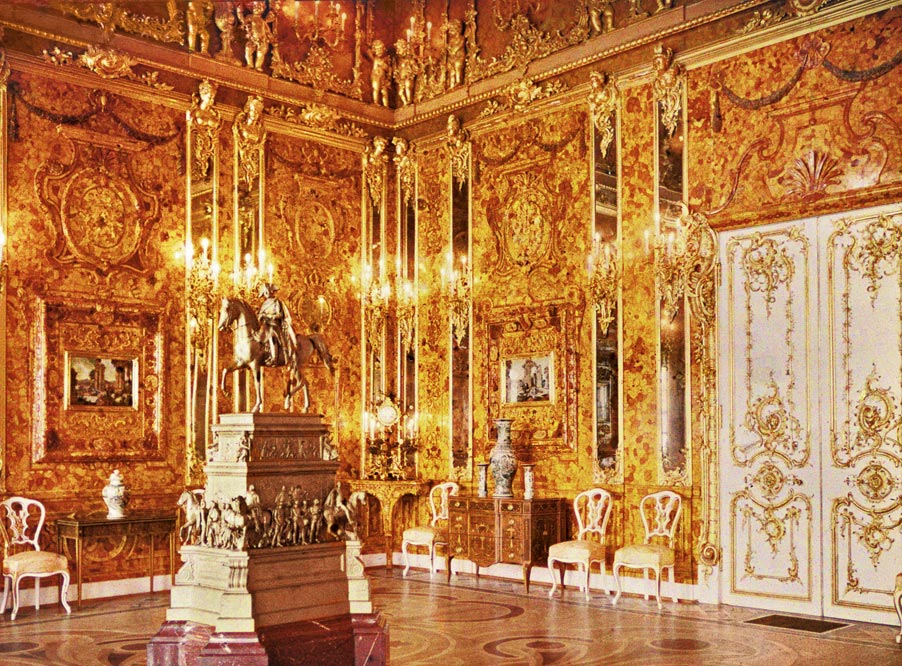
Once hailed as the Eighth Wonder of the World, the Amber Room was an extraordinary architectural artwork – a glittering chamber made from over 6,000 kilograms of amber, inlaid with gold leaf, mirrors, gemstones, and gilded statues of angels and cherubs.
Designed in 1701 by German sculptor Andreas Schlüter and amber artisan Gottfried Wolfram, it was later gifted by the King of Prussia to Tsar Peter the Great and installed in the Catherine Palace near St Petersburg, where it dazzled visitors for over 200 years.
Glowing like molten gold in candlelight, the room was a marvel of architecture and craftsmanship. Every panel shimmered with warmth and light. Estimates of its modern-day value is well over $500 million.
The Disappearance During World War II
When Nazi Germany invaded the Soviet Union in 1941, curators at the Catherine Palace attempted to protect the Amber Room by removing the panels, but they were too fragile and time was short. Instead, they tried to conceal it behind wallpaper.
German forces discovered the room, dismantled it over the course of several days, and transported it to Königsberg Castle in East Prussia (now Kaliningrad, Russia). There, it was installed and put on public display at the city’s museum.
Then, in 1944, as Allied bombing raids intensified, the Amber Room vanished. Historians believe that the panels were either crated up and hidden, or destroyed when Königsberg Castle was heavily bombed by the Royal Air Force in August of that year. The Nazis were known to evacuate important artworks and treasures as they retreated, but no conclusive records of what happened to the Amber Room were ever found.
Strange Sightings and Decades of Searching
Since its disappearance, the Amber Room has captivated treasure hunters, historians, and conspiracy theorists. Over the decades, there have been tantalising clues – but no definitive answers.
In 1997, a mosaic panel from the Amber Room resurfaced in Germany. It had been in the possession of the son of a former German soldier who claimed his father had helped dismantle the Amber Room in Königsberg during the war. The panel – one of four Italian stone mosaics that once adorned the original chamber – was returned to Russian authorities and later incorporated into the reconstructed Amber Room at the Catherine Palace. Its recovery fuelled renewed speculation that other fragments, or perhaps even the entire original room, might still be hidden.
Other alleged sightings have pointed to various possible hiding places: a sealed mine in the Ore Mountains on the German-Czech border; a bunker in Poland; or aboard the Wilhelm Gustloff, a Nazi ship that was sunk by a Soviet submarine in 1945. None of these leads have yielded definitive results.
In the early 2000s, a group of German treasure hunters exploring a cave system in eastern Germany discovered hidden tunnels they believed might conceal wartime loot – including, potentially, the Amber Room. Despite the media frenzy, the search came up empty.
To this day, rumours persist. Some believe that pieces are still in private collections, passed down quietly through generations. Others suspect that the Soviet authorities may have secretly recovered the room and chosen to keep it hidden for political reasons. Yet no evidence has ever confirmed these theories.
A Dazzling Replica, But the Mystery Endures
In 1979, the Soviet government launched a project to reconstruct the Amber Room at the Catherine Palace, using black-and-white photographs, detailed drawings, and surviving design plans as references. One of the greatest challenges was the lack of skilled amber craftsmen, as the specialised techniques required to carve and shape amber had largely faded from practice and had to be carefully rediscovered. Russian artisans spent over two decades recreating the room’s intricate panels and gilded features, working with more than 350 different shades of amber. The restored Amber Room was finally unveiled in 2003, coinciding with the 300th anniversary of the founding of St Petersburg.
Though the replica is stunning, it is not the original. The fate of that glittering, singular work of art remains one of the most tantalising mysteries in modern history.
Where is the Amber Room? Is it hidden in a forgotten bunker, buried in a mine, or resting at the bottom of the sea? Until it is found – or confirmed destroyed – it remains a glittering ghost of the past, a vanished wonder that continues to haunt the world of art and intrigue.
Image Credit: Андрей Андреевич Зеест, Public domain, via Wikimedia Commons

